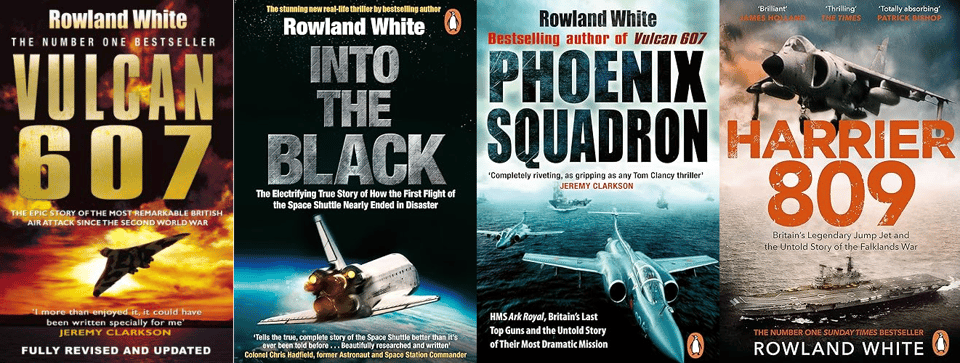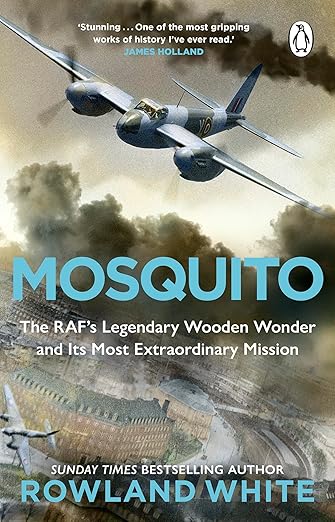Stretching The Narrative Elastic
Or when the square peg of a formula meets a round hole of a subject.
Roland White is one of my favourite non-fiction authors. Writing in the field of aerospace, he’s hit on a simple yet effective formula that creates engaging and informative stories.

White takes a particular aircraft, or spacecraft, identifies an iconic mission or campaign that the craft carried out, then writes a book that tells the story of that mission or campaign while weaving in through flashbacks the history of the craft and the crew or crews that flew that mission or campaign. The first chapter will be the start of the mission, the final chapter will be the end of the mission, and in between the narrative weaves between the continuing story of the mission and the back story that got the craft and its crew to that point.
Vulcan 607 tells the story of the famous (first) Avro Vulcan bombing raid on the Port Stanley airport during the Falklands War, and the story of the bomber itself from its development in the early 1950s through its operational Cold War use.
In Into the Black, White tells the story of the maiden launch of the Space Shuttle Columbia in 1981, while weaving in lots of history not only about the development of the Shuttle but about the stories of that missiion’s two crew members: John Young, moonlander, and the first man to fly into space five times, and Bob Crippen, who was making his first spaceflight having come to be a NASA astronaut via the cancelled 1960s USAF astronaut programme and its Manned Orbiting Laboratory (a manned spy satellite). The story comes full circle when Columbia loses tiles on ascent, and NASA is able to use a CIA spy satellite to examine the shuttle’s underside for damage, a capability that Crippen and his fellow former MOL astronauts were security-cleared to access due to their previous role.
Phoenix Squadron tells the story of a dangerous and challenging Cold War-era sabre-rattling mission carried out by two Blackburn Buccaneers operating from HMS Ark Royal in the dying days of the Royal Navy’s conventional aviation capability, weaving in the story both of the Buccaneer and of how the post-war Fleet Air Arm maintained an elite capability from an increasingly small force.
And finally, Harrier 809 describes the formation and deployment during the Falklands War of a new, third, Harrier squadron, assembled from FAA training units and RAF ground attack Harriers and sent south on the merchant ship Atlantic Conveyor to supplement the existing two Harrier squadrons, 800 and 801, aboard HMS Hermes and HMS Invincible.
All brilliant books, which I greatly enjoyed, where you zoom through the wealth of engaging background detail while gripped by the tension of the ongoing mission.
But then we get to the book of White’s that I’m currently reading, Mosquito.

The tag line promises more of the same, the story of the De Havilland Mosquito interspersed with its most iconic mission. But there’s just one problem: as a legendary World War II aircraft that served as a night and day bomber, a night fighter, and a photo-reconnaissance aircraft, the Mosquito didn’t have one iconic mission, it had loads of them. In particular, it was famous for daring, low-level, pinpoint bombing missions of specific targets.
I believe the “iconic mission” featured in this book is an attack made in Copenhagen in 1945 in the dying days of the war. I say I believe, because I’m only half way through the book, and the book starts with an entirely different mission, a 1943 attack on a factory in Copenhagen. Half way through, the book hasn’t yet got to the designated iconic mission, but has featured an attack on a prison holding resistance fighters in France, an attack on a Gestapo headquarters in Holland, and an attack on some SS barracks in France.
These are all different attacks, carried out by different crews, and described in their entirety in each go, which means that we lose that increasing narrative tension we get when a single mission or campaign forms the spine of the story. Additionally, in an effort, perhaps, to add that missing spine, a good half of the book is telling the tale of the Danish resistance, presumably leading up to that final, yet-to-be-told mission.
It’s a good book, but I’ve found it disjointed, and it lacks that “adventure story novel” feel that the earlier books had. It’s not the book I expected to read. And frankly, it just feels like slightly heavy going. I’m dipping into it a chapter at a night, and finding myself getting confused between all the different characters.
I think the point here is that you can have a good formula or template, but you have to be aware of the limitations of that formula or template. There’s an envelope within which it will work, but outside of it, it might not. In this case, it needed one mission iconic enough to hang the whole book on. If there wasn’t one, and perhaps in this case there wasn’t, then maybe this wasn’t an aircraft suitable for that formula.
But as always, YMMV, and what the hell would I know, anyway?